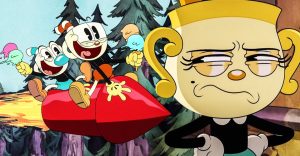The Phantom Menace: 10 Things That Make It The Best Star Wars Prequel Film

The Star Wars prequel trilogy got off to a rocky start with The Phantom Menace. After months of hype, the movie received mixed reviews from critics and was rejected by a large chunk of the saga’s fan base. The most common complaints about the movie – its disjointed pacing, its clunky CGI, the cringe humor of Jar Jar Binks, etc. – are certainly valid points.
But elements like Darth Maul’s intimidating presence and the thrilling podracing sequence overshadow those concerns and make The Phantom Menace arguably the finest entry in the prequel trilogy.
10 Obi-Wan Gets The Perfect Origin Story

While The Phantom Menace primarily functions as an origin story for Darth Vader, it also gives the perfect backstory to a different Star Wars icon: Obi-Wan Kenobi.
Obi-Wan begins The Phantom Menace as a naive padawan with a lot to learn. He couldn’t be further removed from the wise veteran warrior played by Alec Guinness in the original trilogy. By the end of the movie, he’s the first Jedi to defeat a Sith Lord in 1,000 years, well on the way to becoming the legend that fans know and love.
9 It Subverted The Audience’s Expectations At Every Turn

According to former Disney chief Bob Iger’s memoir The Ride of a Lifetime, when the studio first screened The Force Awakens for George Lucas, he was disappointed that it rehashed the narrative of the 1977 original instead of taking new leaps forward.
This is the polar opposite of what Lucas previously did with the prequel trilogy. The Phantom Menace deliberately distances itself from the original trilogy with new worlds, new designs, and all-new storylines like a motorsports tournament and squabbling among the elected officials of a democratic space government.
8 Liam Neeson Makes An Unforgettable Impression As Qui-Gon

Liam Neeson’s Qui-Gon Jinn only needed one movie to become a Star Wars icon. It’s easy to see why Obi-Wan ended up being so wise and level-headed in the original trilogy, because the Jedi Master who trained him is such a wholesome role model.
Qui-Gon shares tangible father-son dynamics with both Obi-Wan and Anakin. He’s the epitome of what a Jedi should be and his influence lasts long after he’s tragically struck down before his time.
7 The Podrace Is A Unique Set Piece

Space battles and blaster duels can be compared to set pieces from other sci-fi blockbusters, but the podracing sequence in The Phantom Menace is utterly unique. It translates the high-octane thrills of motorsports into the delightfully bizarre context of a galaxy far, far away.
This set piece has a story structure of its own: Anakin faces more and more obstacles as each lap passes, constantly raising the stakes until the sequence culminates in a climactic showdown between plucky Anakin and his arch-rival Sebulba.
6 Padmé Gets In On The Action

Padmé would be increasingly sidelined as the prequel trilogy went on. She only gets a couple of action scenes in Attack of the Clones and spends the majority of Revenge of the Sith in her apartment. Back in The Phantom Menace, she had real agency and got in on all the action.
She’s not the kind of monarch who sends her troops into battle from the safety of a palace; she’s the kind of monarch who fights on the frontlines with them. She disguises herself as a handmaiden so she can accompany Qui-Gon into a dangerous Tatooine neighborhood, and fearlessly fights to reclaim her kingdom in the final battle.
5 “Duel Of The Fates” Is Arguably John Williams’ Greatest Composition

One of the few aspects of the prequel trilogy that lives up to the original trilogy is John Williams’ music. Williams’ score continued to pair perfectly with Lucas’ pulpy storytelling. “Across the Stars” captures the tragic undertones of Anakin and Padmé’s forbidden romance, and “Battle of the Heroes” conveys the explosive emotions behind Obi-Wan’s climactic duel with Anakin on Mustafar.
“Duel of the Fates,” the grand, operatic piece that plays over the climactic set piece of The Phantom Menace, is arguably Williams’ greatest composition – even taking his work on the original trilogy and other iconic movies like Indiana Jones and Jaws into account.
4 Darth Maul Is Palpatine’s Most Terrifying Apprentice

Palpatine took on a different Sith apprentice in each of the prequel movies: Darth Maul in Episode I, Count Dooku in Episode II, and General Grievous in Episode III. They’re all great characters, but Maul set a benchmark in The Phantom Menace that was never surpassed.
Dooku and Grievous are unforgettable side villains, but Maul is infinitely more intimidating. He looks like the devil and he’s a master martial artist that can take on two Jedi Knights alone. Maul successfully followed up the iconic menace of Vader with a new memorable villain, which was a seemingly impossible feat in hindsight.
3 The Climactic Lightsaber Duel Is One Of The Saga’s Best

Lightsaber duels are a fan-favorite element of Star Wars movies, and The Phantom Menace’s captivating climactic duel between Qui-Gon, Obi-Wan, and Darth Maul is one of the saga’s greatest, thanks to the high stakes (the duel determines Anakin’s fate) and Ray Park’s unparalleled martial arts skills.
This duel is so compelling that whenever the sequence cuts away to one of the other concurrent set pieces, like Padmé reclaiming her throne or Jar Jar on the battlefield, audiences are just waiting for Lucas to cut back to Jedis’ struggle to defeat the Sith Lord.
2 Qui-Gon Has The Trilogy’s Most Heartbreaking Death Scene

When Obi-Wan is separated from the climactic lightsaber duel by a laser barrier, Qui-Gon struggles to fight Maul alone and gets stabbed in the torso. After bisecting Maul with Qui-Gon’s lightsaber, Obi-Wan joins his dying master at his side and his final wish is for Anakin to be trained as a Jedi. Knowing Anakin’s fate, Qui-Gon’s death is all the more tragic because he chose the wrong hill to die on.
There were a bunch of other heartbreaking death scenes throughout the trilogy – namely all the Jedi who got slaughtered in the purge – but Qui-Gon’s remains arguably the saddest demise from all three movies (unless Anakin being encased in the Vader suit counts as a character death).
1 It Uses The Inevitability Of Fate As A Dramatic Tool

When The Phantom Menace hit theaters, some Star Wars fans were disappointed that the kid destined to become Darth Vader was introduced as a kind, innocent little boy. But Lucas used the promise that Anakin would eventually turn to the dark side as a dramatic tool.
All the best prequels utilize the inevitability of fate. He might seem sweet and harmless now, but no matter what, this adorable little podracer will one day become the most feared man in the galaxy.
About The Author


















